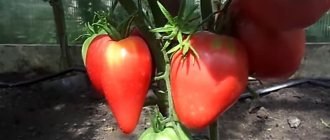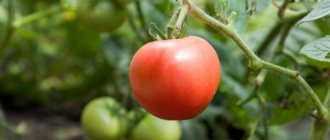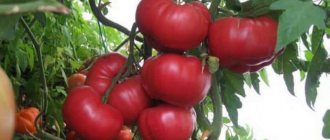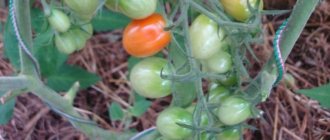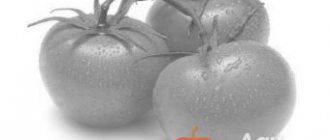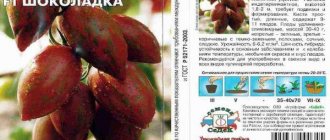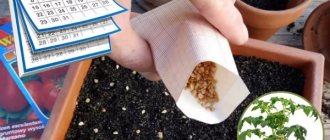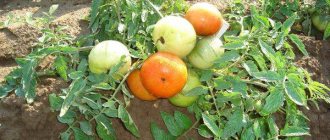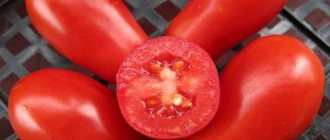Vegetable growing » Tomatoes
1
1853
Article rating
Kira Stoletova
Russian breeders have developed a hybrid tomato variety, Gina TST. The fruits of this variety are large and have excellent taste. The Gina TST tomato has a high yield and is characterized by early ripening. This sets it apart from other varieties.
Description of Gina TST tomatoes
The description of the variety says that the use of the Gina tomato is limited. They are not suitable for pickling. It is recommended to consume the fruits fresh, in salads.
Description of tomato Gina TST
The Gina TST tomato, the characteristics and reviews of which are given in the article, is recommended for cultivation in all climatic zones of the Russian Federation. It is suitable for cultivation both in open ground and in greenhouses and greenhouses.
If you believe the reviews of those who planted the Gina TST tomato and the photos they presented, the main difference between the variety is the shape of the plant. However, experts also say that it is classified as determinant or limited in growth. Its height is 50-65 cm. It grows in the form of a small but powerful bush. Immediately 3-4 thick, densely leafy shoots emerge from the root.
Attention!
Many gardeners confuse this variety with a variety with a similar name. However, Gina is a variety that differs significantly from D. TST in the size and color of the fruit. Although both varieties are low-growing and quite productive.
The leaves of the tomato are medium-sized or slightly larger. The leaf blades are dense, fleshy in appearance, with a slightly noticeable drooping. The color of the tops is rich, dark green. In the photo of a blooming tomato by Gene TST, it can be seen that it forms simple inflorescences of light yellow color, collected in brushes of 3-5 pieces.
The fruits of the Gina TST tomato are classic tomatoes, which is confirmed by reviews and photos taken by vegetable growers. Large, almost regular round shape, with slightly pronounced ribbing at the stalk. The average fruit weight is 200-280 grams. But real heroes weighing 400 grams are far from uncommon.
The color of a tomato at the stage of technical maturity is orange-red or red with thin blurred stripes of a yellow tint. Upon reaching biological maturity, they become bright red and very appetizing in appearance.
When describing the taste qualities of Gina TST tomatoes, they note a balanced taste, high sugar content, meatiness and juiciness. The skin of tomatoes is dense. The pulp of tomatoes is fleshy, somewhat loose. Sugar content appears on the cut. At the same time, tomatoes are juicy due to the formation of 6-8 chambers filled with juice and a small amount of small seeds.
Care and pest control
The Gina tomato is very unpretentious. The most important thing for him is regular watering, weeding and fertilizing. After planting in open ground, it is necessary to make the first feeding after 2 weeks. After 10-15 days, the procedure is repeated. Fertilize the plant for the third time after 20-25 days.
It is important to follow the watering schedule. Tomatoes really don’t like excess moisture.
In this case, the risk of rotting of the root system and death of the bush increases. When the tomato is in active flowering, it is added 2-3 times a week, as the top layer of soil dries. And when the fruits are already ripening, irrigation must be more frequent and carried out exclusively at the root.
The advantage of the Gina variety is its resistance to the main diseases of all nightshade crops. But sometimes tomatoes can be affected by:
- aphids - the fight against them is quite simple. It is necessary to make a steep decoction of onion peels and wormwood and spray all the bushes. You can also use a soap solution;
- mole crickets and wireworms are more serious enemies. They live in the upper layers of the soil and infect the rhizome of the plant. To combat them, you need to arm yourself with chemicals: Confidor, Medvetox and others.
Determining the presence of pests is easy. Aphids are immediately visible on the surface of the leaves, and by the wilting of the plant, you can determine the presence of mole crickets and wireworms in the ground.
Having seen the description and photo of the Gina tomato variety, any gardener will not be able to resist. After all, having such a tomato in your garden can provide you with an excellent harvest.
Characteristics of tomato Gina TST
Gina TST, like other tomato varieties, is not frost-resistant. Even at zero temperatures, the leaves turn black and wither. With small lesions, tomatoes produce new shoots, but the yield decreases. However, the Gina TST tomato develops well in cool weather without forming empty flowers. It cannot be called drought-resistant, but the variety also does not like waterlogging.
The tomato is a mid-season variety with an average fruiting period. It enters the technical maturity stage 100-110 days after emergence.
Typically, such tomatoes are removed for further storage and transportation. But Gina TST has a thick skin. They ripen well on the branches. Its fruits are not prone to cracking during transportation and storage. It is for these characteristics and excellent taste that farmers love the variety.
The yield of Gina TST tomato declared by Agro LLC is 6-10 kg/m². But many vegetable growers claim that it is much higher. In conditions of good lighting and a lot of warm days, you can collect up to 20 kg/m². Of course, if you don’t neglect fertilizing and watering.
Tomato Gina bush formation. Description and characteristics of the variety
Is the Gina tomato a variety or a hybrid? Interested in all gardeners planning to include valuable tomato seeds in their list. Gina is a mid-season variety. Seed material can be harvested independently and used for planting: there will be no loss of characteristics during subsequent sowings, as with hybrids. It should be distinguished from the early orange hybrid.
The tomato variety Gina "Aelita" ripens in an average time - 116-125 days from planting. The bush forms 7-8 fruiting clusters.
Characteristics of tomatoes:
- round shape;
- the skin is dense and does not crack;
- average weight 150-200 g.
The Gina tomato is a determinate, medium-growing variety. Branching and foliage are moderately expressed. The bush does not form trunks. Requires garter due to heavy fruiting clusters that can break.
The Gina tomato variety from Siberian Garden is famous for its productivity. Tomatoes are good for canning, fresh salads, ketchups and sauces. The fruits are dried and used for pickling.
Tomatoes grow up to 1 m in height in greenhouse conditions; in open beds, shoots reach 50-60 cm. The bushes do not require pinching or pinching.
The variety belongs to the dessert varieties. It has fleshy, moderately juicy pulp. The taste harmoniously combines sweetness and tomato sourness.
Country of origin, year of registration
The variety appeared in Holland. Entered into the State Register in 2005. Now produced by seed-growing agricultural companies:
- "Gavrish";
- "Aelita";
- "Sedek."
Where is the best place to grow?
The variety is intended for planting in:
- central regions under the film;
- middle zone in shelters;
- in the Urals in greenhouses;
- in the south in open beds.
Method of use
The Gin variety is used universally - fresh, in hot first and second courses, for winter preparations. Sun-dried tomatoes in pieces are delicious, in the tradition of Italian recipes.
Planting and care
The Gina TST tomato is grown in seedlings in the climatic conditions of the middle zone. Only in the southern regions is it possible to plant seeds in the ground.
They begin sowing seeds for seedlings in the second half of March. If you plan to grow Gina TST in a greenhouse, then work begins in the middle of the month. Otherwise, you should wait a couple of weeks.
Attention!
Many vegetable growers are misled by the abbreviation TST and consider the variety to be a hybrid. This is wrong. Therefore, you can safely collect Gina TST tomato seeds yourself. Just don’t forget to treat them with any antifungal drug before sowing.
Sowing is carried out in containers tightly filled with soil. It can be bought at the store or prepared at home. To do this, just mix garden soil, humus and peat in equal proportions. Many people use coconut fiber as a leavening agent instead of peat.
Gina TST tomato seeds are laid on the surface, leaving a distance of 2-3 cm between them. Mulch on top with a layer of prepared soil about 1 cm high. Moisten generously with a spray bottle, cover with glass or film and place in a warm place for germination. Shoots appear on days 5-7.
Subsequently, seedlings:
- transferred to a well-lit place;
- water in a timely manner;
- at the stage of 2-4 true leaves, pick up in separate pots;
- Before transplantation, 3 fertilizing with mineral fertilizers is carried out.
Gina TST tomatoes are planted in the greenhouse in the first half of May. In open ground towards the end of the month, when the threat of night frosts has passed. You can plant it earlier if the soil has time to warm up to 10-12 degrees Celsius, and provide temporary shelter. It is advisable to prepare the ridges in the fall by digging them up and adding compost or humus. In spring the soil is loosened. Prepare holes, at the bottom of which humus and potassium-phosphorus fertilizers are poured. In acidic areas, add wood ash. The holes are pre-watered. The tomatoes are planted, the holes are closed and watered abundantly again. You can mulch the root circle with sawdust or straw.
Features of care
Tomato raspberry flame
Basic manipulations in the form:
- loosening the soil;
- abundant watering;
- weeding;
- prevention of diseases and pests.
No additional care procedures required:
- garter stems;
- formation of plants.
Watering
Solanaceae are a crop that is sensitive to soil moisture, and the Gina variety is no exception.
The following watering periods are noted:
- When the top layer of soil dries out.
- During flowering, manipulation is carried out at least twice a week.
- When forming tomatoes, watering is organized every other day.
- If the air temperature rises above 28°C, the procedure is carried out daily.
Depending on the condition of the soil and temperature conditions, from 0.5 to 1 liter of water per bush is required.
Top dressing
To fertilize nightshades, compositions like:
- "Emerald";
- "Ideal";
- "Gumatom-Universal";
- "Green fertilizers";
- organics of various types.
Before the procedure, the plants are actively watered with rain or settled water. The optimal time for manipulation is early morning or late evening.
Fertilizer scheme:
- Two weeks after transplantation.
- 10 days after the first feeding.
- Two weeks later.
- After 20 days from the third fertilizer.
Root feeding alternates with foliar feeding, however, after the ovaries appear, foliar manipulations are not used.
Formation and garter of bushes
Thanks to the breeding characteristics of the Gina variety, its plants do not require care in the form of shaping and staking. Low, strong shoots cope well with the load, sinking to the ground when the fruits are especially large. This retains moisture for the root system. However, if the climatic conditions are characterized by a large amount of precipitation, the shoots can be tied up, thereby protecting the tomatoes from diseases associated with increased dampness.
How to protect plants from overcrowding
Recommended planting pattern:
- No more than 3–4 bushes are planted per 1 m2.
- Leave up to 70 cm between rows.
- A distance of 50 cm is maintained between plants.
Subsequently, the leaves that shade the ripening fruits are removed.
Features of growing in a greenhouse
The nuances of this method are:
- The need for staking of plants, since in greenhouse conditions the shoots are taller and thinner than those grown in open ground.
- The need to control soil moisture.
- Ensuring active air circulation.
Diseases and pests
According to the descriptions of the variety, the Gina TST tomato is resistant to verticillium wilt and fusarium. Relatively resistant to late blight. To avoid tomato diseases, preventive measures are taken, namely watering at the roots, regular ventilation of greenhouses, and spraying plants with antifungal drugs.
Tomatoes are rarely affected by pests. The most common of them are spider mites and aphids. When they are detected, the bushes are treated with chemicals or folk remedies.
Advantages and disadvantages of the variety
Many summer residents value this variety for its stable yields, good taste of tomatoes and high resistance to diseases. The culture does not require care, so there is nothing difficult in growing it.
Thanks to their early ripening, Gina TST tomatoes have time to ripen on the branches
pros
- good yield;
- presentation of tomatoes, large sizes;
- good taste;
- long-lasting shelf life and transportability;
- high immunity.
Minuses
- needs to be pinched and tied up;
- Gina TST tomatoes are not suitable for canning in their entirety.
Reviews of the tomato variety Gina TST
Maria, 40 years old, Ryazan I love Tomato Gina TST for his short stature. Much easier to care for. Many people prefer higher grades. They say their productivity is higher. Not true. The harvest is quite high. The only drawback is that the stems break under the weight of the fruit.
Olga, 48 years old, Serpukhov I grow tomatoes in open beds. Gina TST has never failed. Cold or hot, I always have a harvest of excellent tomatoes. The kids really like the tasty and sweet ones. It's a shame they don't fit into the jar. It won't be possible to roll it up.
Care and protection from pests
No special agrotechnical techniques are described for Gin varieties. Therefore, planting care in this case will consist of standard measures:
- watering;
- loosening;
- weeding;
- tying;
- application of fertilizers.
Watering plants should be done twice a week. It is especially important during the fruiting period. At this time, you need to water the bushes every other day. In a situation where the air temperature is 28ºC or higher, watering must be done every day.
After each watering, the soil around the plants needs to be loosened. This should be done very carefully so as not to damage the root system of the bushes. Plantings also need to be weeded periodically to remove weeds. This will allow the tomatoes to use all the nutrients available in the soil to produce a bountiful and tasty harvest.
It is worth noting that in regions of our country where there is a hot climate, it is better not to garter tomatoes of this variety. In such a situation, the bush will “lie down”, and the developed powerful leaves will cover the root system of the plants from the scorching sun. It must be remembered that after watering in this situation, loosening should not be carried out.
The process of pinching does not require special attention in caring for plantings. This is due to the fact that determinate and compact bushes are formed here.
At the same time, it is very important to provide the plants with high-quality and timely fertilizing. The first application of fertilizers should be carried out 2 weeks after transferring the seedlings to their permanent place of growth
The procedure is repeated after 10 days. The third fertilizing should be applied after another two weeks. Fertilizers for tomatoes should be applied for the fourth time 20 days after the third feeding. In this case, watering should be more frequent. Tomatoes need to be fed with mineral complex fertilizers, as well as herbal infusions. To increase the sugar content of the fruit pulp, as well as protect the bushes from pathogenic microflora, you need to water them three times a month with a weak solution of potassium permanganate.
To combat insect pests and diseases for preventive purposes, plantings should be sprayed with solutions from traditional medicine, as well as chemicals.
Remember that proper care, in compliance with all agricultural practices, is the key to strong and healthy bushes, as well as a tasty and abundant harvest.
The tomato variety and hybrid Gina is an excellent vegetable crop that is not particularly difficult to grow and always produces a good harvest.
Features of cultivation
Seedling period
Considering their mid-ripening, it is advisable to sow seeds of the Gina TST variety for seedlings no later than the end of March. They germinate quite quickly and amicably. The seedlings must be immediately moved to the sunniest place and, if necessary (cloudy days, short days), additional artificial lighting must be organized. It is also advisable to reduce the temperature in the first weeks after germination to +16°C-+18°C during the day, and a few degrees less at night. This will promote good development of the root system and the seedlings will not stretch.
In the first weeks before picking, you need to water the Gina TST tomato seedlings very carefully; it is better to dry the soil a little. Because during this period, young plants are very sensitive to waterlogging and easily become infected with blackleg.
Picking tomato seedlings into separate containers
When unfolding the first two true carved leaves, it is necessary to transplant the seedlings into separate containers. It is better to take fairly large pots at once, since after picking the plants will quickly grow and, in order not to do this operation twice, you must immediately take care of a sufficiently large container.
The soil for replanting needs to be more nutritious. As a last resort, you can add a tablespoon of vermicompost or other organic fertilizer to each container when replanting.
Landing in the ground
In the last days of May or early June, seedlings of Gina TST tomatoes can be planted in open ground. These dates are given for areas of the middle zone. Naturally, in more southern and northern regions, adjustments to the timing of landing are necessary. You need to focus on the period in the region when all return frosts will be a thing of the past. Otherwise, additional cover of the planted seedlings is necessary using film or non-woven material on the arches.
Planting a tomato bush in open ground
Tomato seedlings are planted, keeping the plant density per square meter of no more than 3-4 pieces. It would be optimal to plant bushes with a distance between them of 40-50 cm. The row spacing should be about 50-60 cm. It is advisable to immediately install supports for the bushes, since they grow very spreading, and with a large harvest they will lie on the ground. In the southern regions there is nothing wrong with this - there, if desired, tomatoes of this variety can be left without tying or pinching at all.
In middle latitudes, pinching is very desirable, since in this case the bushes will be able to distribute all their strength among the remaining shoots and will delight with early and greater yields. In more northern regions, gartering is also necessary, since branches lying on the ground are more likely to contract some disease.
Harvesting and processing
Gina tomatoes are harvested as the crop ripens. It is not worth keeping them on plants for a long time, so as not to overripe them. After harvesting, the tomatoes can be processed or eaten. Slightly unripe fruits are collected for sale.
The purpose of the harvest is universal. Juicy tomatoes are often used in summer salads or simply eaten fresh, straight from the garden. They are incredibly tasty, sweet, and healthy. You can also use the harvest to prepare winter preparations (salads, sauces, juice, borscht dressings).
Gina tomatoes are harvested as the crop ripens.
Interesting!
The whole Gina tomato is usually not canned due to its rather large fruits. But this is possible; they usually do not crack in jars, since the skin of the Gina variety is strong, unlike the Gina TST hybrid.
Characteristics of the variety
The Gina TST tomato variety is highly valued for its versatility and quality indicators. It is widely used due to its bright red fruits, which have a wonderful presentation and taste.
Description of the plant and fruits
The fruits of the crop ripen on determinate bushes. On average, plants reach 55-65 cm in height. 2 or 3 stems are formed on the plant. The plant has medium leaf density. They are small, dense and thick. They are characterized by a light green color and a slightly rough surface.
The bushes are relatively low-growing. Shoots tend to grow. In dense plantings, neighboring shoots may shade each other. Therefore, experienced gardeners advise planting no more than 4 plants per 1 m².
The variety is considered quite strong, but it should still be tied up to avoid collapse and damage to the branches under the pressure of heavy ripening fruits. The lower leaves should be removed, which will provide more air to the bushes and will have a beneficial effect on the immunity and growth rate of the crop.
Tomatoes are round, sometimes slightly oval. The average weight of one is 250-350 g. If the variety was grown in greenhouse conditions, the weight can reach 400 g.
The fruits of this variety are always fleshy and juicy. The skin is smooth and thin, but dense. The color of the fruit in technical ripeness is light green, in full biological ripeness it is bright red.
Due to the structure of the outer covers and pulp, they are not damaged during transportation. The skin does not crack or burst. The fruits have excellent commercial characteristics. They are more suitable for fresh consumption (in salads and other dishes).
They are not used for preservation or pickling due to their large size.
Productivity
The variety begins to bear fruit within 3.5 months after planting. If you sow Gina TST tomatoes for seedlings at the end of March, you can harvest them already at the end of June - beginning of July.
Average yield: with proper and timely care, the volume of harvested vegetables will reach 18-20 kg per 1 m².
Low temperature resistance
The plant is no different from other tomato varieties in its heat-loving nature. It can easily die due to a sharp cold snap or early frosts. This factor brings a lot of trouble to gardeners.
To preserve the crop and prevent hypothermia, after planting, it is better to cover the bushes with special material for the first time.

